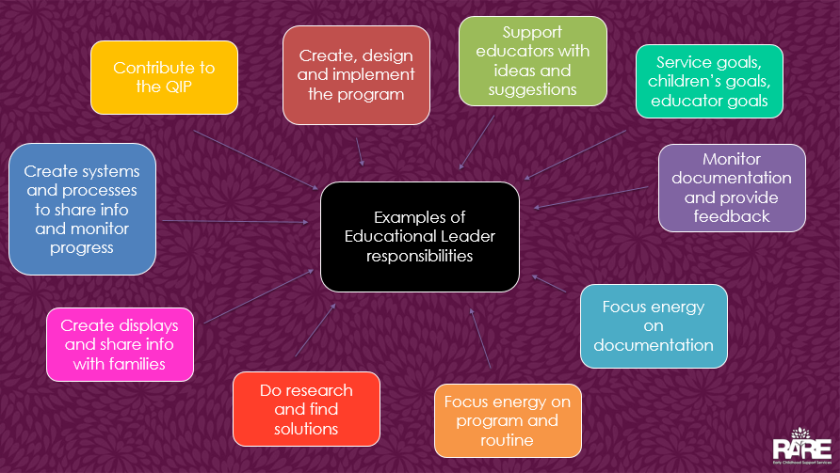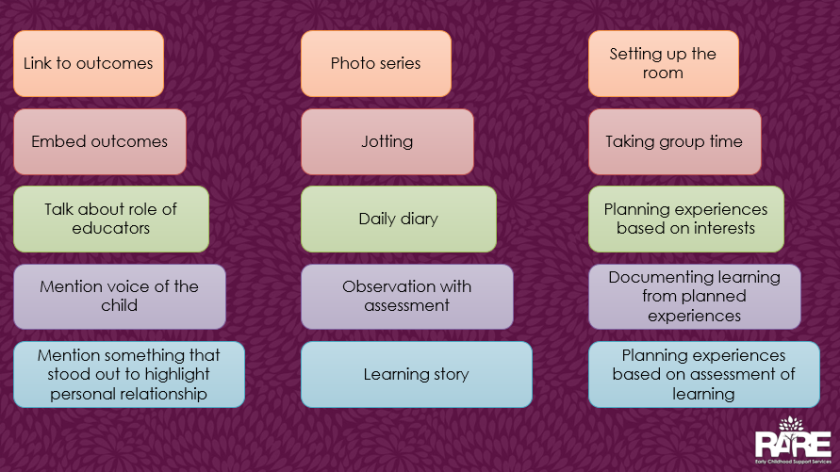So, you have agreed to be the educational leader and are now thinking “what does that mean?”. Or perhaps you have been one for a while and are still a bit confused by what your role is. There is no one clear definition but the information below might help you to understand your role and also support your team.
Make sure you have a position description or at very least a clear understanding of what the expectations are in your service around your role. Your position description can cover off any of the following items depending on the focus of your service, your philosophy, your QIP goals, the needs of your stakeholders and more. Here are just a few ideas of what your position description could focus on:

While you may be given the time to be the educational leader and have agreed to the position and have a position description what do you actually do to support your staff? Again this depends on your team and how they learn best. Chances are your educators have a range of learning styles so you will probably have to modify your leadership to suit their individual needs. Below are some ideas and following is some explanations behind a few of them…

- Role modelling: It is very difficult as a leader to ask those in your team to perform up to their capabilities if you are not consistently doing this. Leadership is not about “do as I say, not as I do”. Your interactions, programming, displays, documentation, and discussions with families all should be an example for others to learn from.
- Providing rationales: This has 2 key benefits, it helps share your knowledge to the person you are talking to so they may develop their skills. The other is that educators learn the reason behind tasks so if they are asked to explain practices during assessment and ratings they have an idea of the answers. An example of this is saying “When you are planning follow ups it is best to plan a range of experiences to allow the child to have choice and ensure that one is likely to happen, instead of trying to convince the child to complete the one task you planned”.
- Assigning mentors: If you have a large group of educators it may be impossible to mentor everyone effectively, so assigning the best person to help support and mentor individual educators is a way to support all of the team without being spread to thin among all your tasks. This also builds skills in more senior staff as they have to explain their practices.
- Addressing issues with resources: Often issues arise where staff use the same resources all the time, don’t look after the resources, or struggle to share them with other rooms. Overseeing the use of resources and compliance around this with ensuring appropriate use and care can help children engage with the learning opportunities.
Another idea to support the staff in individual and meaningful ways is to acknowledge every employee brings different skills and knowledge to the service. As such it is sometimes difficult to balance supporting those who need additional help, and not holding back those who are doing well. A staged approach can support this where everyone knows the stages, but works through them at a rate that works for them. Below are a few examples of staged approaches around different focus areas, where educators can start on the top level and progress to the bottom level.

Just remember to document what you do to provide evidence, whether it is discussions, meetings, feedback, plans or staged approaches.
For information from ACECQA on their expectations around Educational Leadership head to https://www.acecqa.gov.au/sites/default/files/2018-01/Guide-to-the-NQF-3-Assessment-and-rating.pdf and page 303.
If you haven’t already done so, why not sign up for the monthly newsletter to get more tips and ideas at http://eepurl.com/b7KQHT


